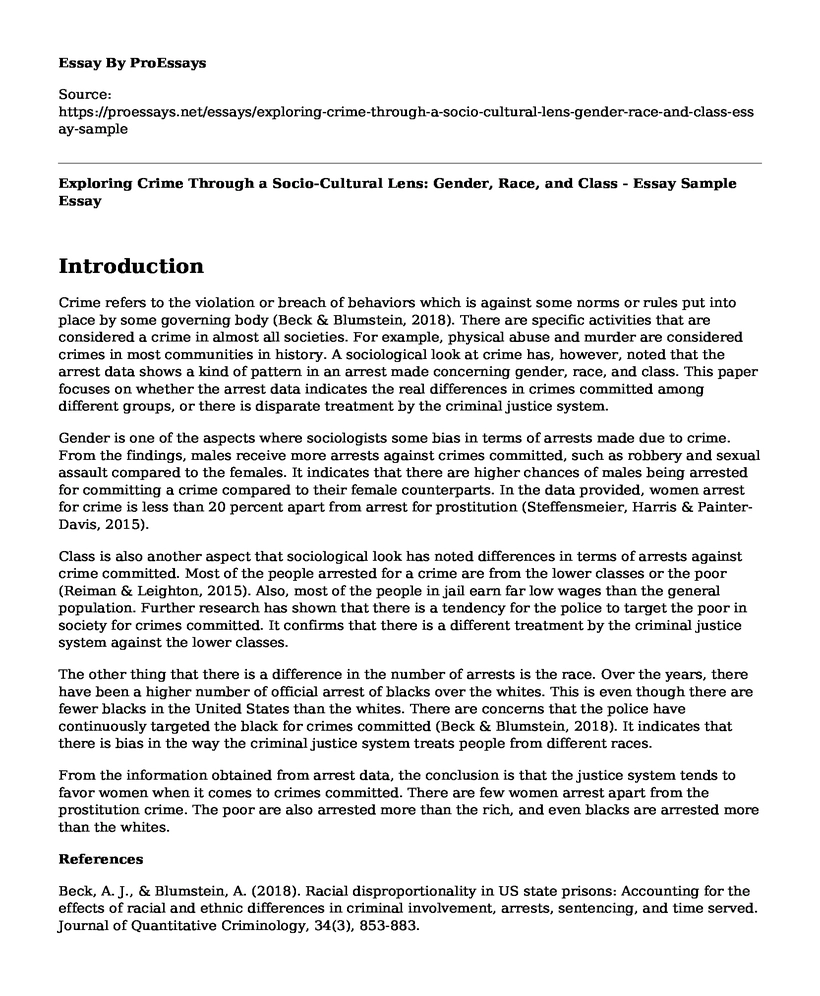Introduction
Crime refers to the violation or breach of behaviors which is against some norms or rules put into place by some governing body (Beck & Blumstein, 2018). There are specific activities that are considered a crime in almost all societies. For example, physical abuse and murder are considered crimes in most communities in history. A sociological look at crime has, however, noted that the arrest data shows a kind of pattern in an arrest made concerning gender, race, and class. This paper focuses on whether the arrest data indicates the real differences in crimes committed among different groups, or there is disparate treatment by the criminal justice system.
Gender is one of the aspects where sociologists some bias in terms of arrests made due to crime. From the findings, males receive more arrests against crimes committed, such as robbery and sexual assault compared to the females. It indicates that there are higher chances of males being arrested for committing a crime compared to their female counterparts. In the data provided, women arrest for crime is less than 20 percent apart from arrest for prostitution (Steffensmeier, Harris & Painter-Davis, 2015).
Class is also another aspect that sociological look has noted differences in terms of arrests against crime committed. Most of the people arrested for a crime are from the lower classes or the poor (Reiman & Leighton, 2015). Also, most of the people in jail earn far low wages than the general population. Further research has shown that there is a tendency for the police to target the poor in society for crimes committed. It confirms that there is a different treatment by the criminal justice system against the lower classes.
The other thing that there is a difference in the number of arrests is the race. Over the years, there have been a higher number of official arrest of blacks over the whites. This is even though there are fewer blacks in the United States than the whites. There are concerns that the police have continuously targeted the black for crimes committed (Beck & Blumstein, 2018). It indicates that there is bias in the way the criminal justice system treats people from different races.
From the information obtained from arrest data, the conclusion is that the justice system tends to favor women when it comes to crimes committed. There are few women arrest apart from the prostitution crime. The poor are also arrested more than the rich, and even blacks are arrested more than the whites.
References
Beck, A. J., & Blumstein, A. (2018). Racial disproportionality in US state prisons: Accounting for the effects of racial and ethnic differences in criminal involvement, arrests, sentencing, and time served. Journal of Quantitative Criminology, 34(3), 853-883.
Reiman, J., & Leighton, P. (2015). Rich Get Richer, and the Poor Get Prison, The (Subscription): Ideology, Class, and Criminal Justice. Routledge.
Steffensmeier, D., Harris, C. T., & Painter-Davis, N. (2015). Gender and arrests for theft, fraud, forgery, and embezzlement: Conventional or occupational property crime offenders?. Journal of Criminal Justice, 43(3), 205-217.
Cite this page
Exploring Crime Through a Socio-Cultural Lens: Gender, Race, and Class - Essay Sample. (2023, Feb 24). Retrieved from https://proessays.net/essays/exploring-crime-through-a-socio-cultural-lens-gender-race-and-class-essay-sample
If you are the original author of this essay and no longer wish to have it published on the ProEssays website, please click below to request its removal:
- Paper Example on Sentencing with Diverse Population Groups
- Sacco and Vanzetti Case Study
- The Difference Between Criminology and Criminal Justice Essay
- Essay Sample on Obama Care: Improving Lives of Millions in Texas
- Hustler Magazine v. Falwell: Supreme Court Ruling in Favor of Magazine - Case Study
- Essay Sample on Protecting Free Speech: A Necessary Human Right
- Free Essay Example on Witness Protocols & Evidence for Crime Scene Investigators







